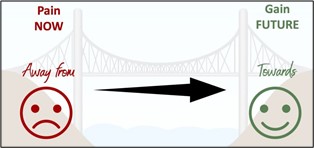The way to start and build a business is grounded in strategy and planning, primarily based on a logical and reasoned approach. But on its own, this is not enough, particularly when it comes to successfully executing the strategy. In the following article, Mike Kemball MBA1982 explains how to apply techniques used in change management to drive change, turnaround and grow businesses.

“Most leaders would agree, they’d be better off having an average strategy with superb execution, than a superb strategy with poor execution. Those who execute always have the upper hand.”
–Steven Covey, Author of ‘The 7 Habits of Highly Effective People’
Execution is dependent on people. Execution relies on the interaction among people to be effective. People are emotional as well as logical beings. And in my experience, under pressure, the emotional is more likely to dominate the logical thinking.
Let me draw an analogy to conventional wisdom, where people are said to have a personality, thinking style, or way of doing things that is either right-brained or left-brained. Those who are right-brained are supposed to be intuitive and creative free thinkers. Left-brained people tend to be more quantitative and analytical; they pay attention to details and are ruled by logic. By utilizing both aspects of the brain, you gain an advantage over those dominated by one side.
The challenge is to build on the logical and reasoned approach to growing a business, while harnessing the emotions which drive human behaviour.
It means working backwards from the perceptions of the people who are stakeholders (be they customers, prospective clients, distribution channels, suppliers, employees, regulatory authorities etc.).
Developing this approach is the equivalent of rotating your viewpoint 180o to gain the human perspective to enhance your reasoned plan.
What drives human behaviour?
People will tend to
- Move away from pain, or something they don’t want
- Move towards their wants and desires, or gain
The energy from these two forces is derived from the intensity of the emotions associated with their perception of what they are moving away from and towards. The greater the intensity, the stronger the drive for change.
You can channel this energy by positioning yourself as the bridge to take someone from where they don’t want to be to where they want to be, at both an organisational and an individual level.

To help people and organisations make the transition:
- They need to feel it’s worth making the journey. This is achieved by tapping into and leveraging their drivers, increasing both the clarity and intensity of the associated emotions.
- They need to believe you can take them to the promised land by bridging the chasm that separates them from where they want to be. This is built on rapport, trust and credibility.
And so the journey begins …
The Dynamics of Push versus Pull
In reality, other people don’t care at all about you, your product or your company. Their main concern is themselves. So, allow them to talk about themselves, whoever they are. And stop talking about you, your product and your company, at least until you have elicited their drivers.
Pull and push are about the dynamics of an interaction, which can be confused with active and reactive.
You can be active and use the pull dynamic. Active and reactive are two different ways of acting and being in the world, effectively cause and effect. An action (which may be a thought, feeling, or practice) is active when it takes something as its object; conversely, it becomes reactive when it is made the object of someone or something else.
What happens when you try to push someone in one direction or the other? They push back, they resist. And the harder you push, the harder the other person pushes back. You are now in a situation where you have locked horns, with nowhere to go without someone losing face. This is not a good place to be, and it is certainly not a win-win proposition.
How can you use this tendency for people to “push back” to your advantage? Do the opposite of what they expect! Rather than push the other person in the direction you want them to go, pull them in the opposite direction. The other person’s tendency will be to “pull away” from you, resulting in them moving in the direction you originally intended. Like a pendulum, if you pull it one direction and let it go, it swings in the opposite direction.
To fully engage people in a change programme, the conversation needs to flow back and forth like a ball in a game of tennis, using a mix of push and pull strategies. ‘Pushy‘ implies the giver is not interested in the receiver. Asking questions allows the receiver to pull you in. This ebb and flow of give and take contrasts with the one-way linear approach dictated by most strategies and business plans.
For further information, ‘10 Reasons people resist change’ is an excellent article in Harvard Business Review by Rosabeth Moss Canter.
The Way Forward
Many start-ups have great products and technology, combined with strategies and plans but they never reach success because they cannot connect to a customer in a way that results in sales. While you can blame marketing, product market fit, or go to market approach, sales is what matters to survival, particularly at the beginning where the two things a start-up needs immediately are sales income and feedback on the product.
The reasons for failure in start-ups almost always relate to execution, and more specifically, selling. Follow the link for a recent list of reasons for failure in start-ups.
My contention is that by applying the approach and techniques used to drive change management, your ability to execute your strategy improves. The result is greater success for your business.
About the author: Mike Kemball is a sales transformation expert with 30+ years as an accomplished interim Sales Director and Managing Director in 15+ organisations across Telecom, Technology and Industrial sectors in Europe, India, Africa and the Middle East. Client companies and subsidiaries managed were typically $10m – $300m in revenue with sales teams from 10 up to 250 people.
As an experienced hands-on change agent and trouble-shooter, Mike converts the high-level strategy into the reality of the day-to-day sales operation. His work is done when the change is embedded and the organisation operates at the required higher level of performance. He holds an MBA from London Business School.
